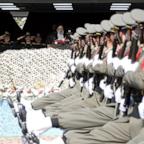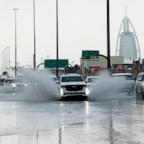Satellite Collision Puts Hubble at Risk
Satellite collision highlights the danger of space junk to precious gear.
Feb. 13, 2009— -- The already hobbled Hubble Space Telescope could be further harmed by space debris from Wednesday's unprecedented satellite collision, a chief NASA scientist told ABC News.
There has always been a small risk that Hubble and other spacecraft could be damaged by the thousands of pieces of junk floating through space.
But now that the space telescope is orbiting 75 miles below where the collision took place, experts say the risk is much greater.
"Clearly debris from the event is going through the altitude that the Hubble flies, so we're going to be looking at what is the new risk to Hubble," said Nicholas Johnson, chief scientist at the Orbital Debris Office at NASA's Johnson Space Center.
When two large satellites crossing paths at hypervelocity -- each weighing more than 1,000 pounds and going 17,500 miles an hour -- collided Wednesday over Siberia at an altitude of 491 miles, it was the first time there had ever been such a crash in space.
No one knows yet why the Iridium communications satellite and an old Russian Cosmos satellite ended up on a collision course.
But now that thousands of pieces of debris left after the collisions are speeding through space, the military's Strategic Command (Stratcom) and NASA are watching carefully to make sure other satellites and spacecraft remained unharmed.
Johnson said that in the region where the collision took place, several operational spacecraft orbit. And even small pieces of debris can do some big damage.
"A particle as small as a fraction of an inch can disable or disrupt a spacecraft's operations. So we obviously have to be concerned with it," he said.
Although NASA is concerned about all spacecraft in the region, the Hubble is of particular concern because the last shuttle mission to repair the telescope is scheduled for this spring.
"One of the issues for Hubble is the shuttle mission in May to go back for the final servicing," Johnsons said. "So we do need to know not only what is the risk to the Hubble itself, but what is the risk to the shuttle crew which will be going up to service it."
Also, unlike other spacecraft, Hubble has no evasive capabilities. If NASA scientists think a piece of debris is about to cross paths with the telescope, it can't rely on rockets or other propulsion capabilities to move it. Their only option is to tilt the telescope so that it presents the smallest cross section possible.




